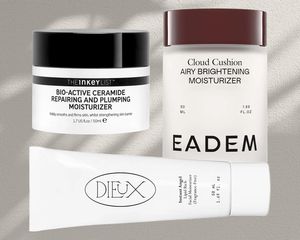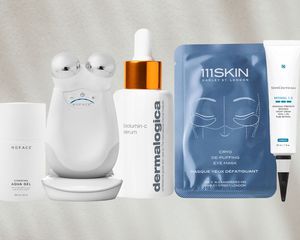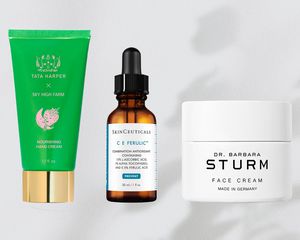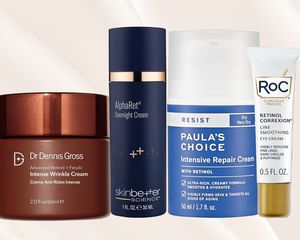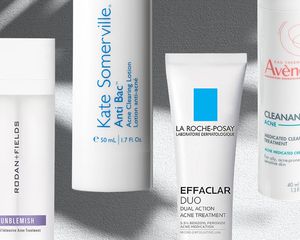:max_bytes(150000):strip_icc()/GettyImages-1198145037-0f42c701973744d398fde9a78c9a9c36.jpg)
Dimitrios Kambouris / Getty Images
We hate to say it (not really), but celeb skincare secrets will forever be our not-so-guilty pleasure. A big round of applause for the famous few who detract from beauty gatekeeping and divulge their go-to practices. We couldn't help but lean in and take notes when the ageless Salma Hayek Pinault revealed that she doesn't use Botox, pills, or fillers—and that her secret weapon is a Mexican botanical called tepezcohuite (sometimes also called tepescohuite in scientific journals). "It's used in Mexico for burn victims because it completely regenerates the skin, and there's no one in the States who is using this ingredient," she told Elle. Needless to say, we sped off in search of all of the tepezcohuite intel we could gather before the ink dried from our notebook page.
We had to know more about this little-known, exotic ingredient Hayek Pinault says is responsible for her flawless skin. So, we spoke with dermatologists Patricia Farris and Rajani Katta, and cosmetic chemist Vanessa Thomas, for their takes on tepezcohuite.
Meet the Expert
- Patricia Farris, MD, is a board-certified dermatologist who is known for her holistic approach to anti-aging treatments.
- Rajani Katta, MD, is a board-certified dermatologist who serves as a Voluntary Clinical Faculty of both the Baylor College of Medicine and the McGovern Medical School, University of Texas Houston.
- Vanessa Thomas is a cosmetic chemist with over a decade of product formulation experience.
Tepezcohuite
Type of ingredient: Anti-microbial.
Main benefits: Moisturizes, and could potentially promote burn- and wound-healing.
Who should use it: In general, anyone with dry or irritated skin.
How often can you use it: Not enough scientific studies have been conducted to determine appropriate usage.
Works well with: Aloe and tea tree oil.
Don’t use with: Harsh exfoliators such as glycolic acid and astringents, as doing so may irritate the skin.
What Is Tepezcohuite?
Also known as "mimosa tenuiflora," tepezcohuite is a bark tree found in Southern Mexico that resembles a fern. The tree does well at regenerating itself in the aftermath of forest fires, and natives of Mexico refer to it as the "skin tree." It was administered by the Mayan culture thousands of years ago to treat skin lesions such as burns, by grinding the bark up into a powder. In 1984, after a horrific gas explosion in Mexico City killed 500 and left more than 5000 with severe burns, the Red Cross treated the burn patients with tepezcohuite. It was so effective at healing their wounds and regenerating the skin that a year later, when an earthquake caused a series of explosions and fires, tepezcohuite was again used to treat victims.
Benefits of Tepezcohuite for Skin
Tepezcohuite is purported to have plenty of benefits, all of which give anecdotal credence to its status as a skincare miracle. However, because it hasn't been widely adopted, scientific studies to determine exactly all the ways tepezcohuite works are sorely lacking. Most of the evidence to the efficacy of this not-yet-hyped ingredient is anecdotal.
- Antibacterial properties: "Tepezohuite is known for its antibacterial activity and has been used for wound healing," says Farris. Thomas notes that some research has shown that the bark has anti-microbial properties, but it is not very efficacious against anti-fungal effects.
- Possible scar reduction: Anecdotal evidence suggest it's been effective in reducing scars, though experts are quick to point out that it hasn't undergone many scientific studies.
- Potential anti-aging ingredient: Farris explains that the bark of the tree has also been made into an extract and formulated into anti-aging creams. However, it’s important to clarify that none of the products with tepezcohuite have been studied in human clinical trials so at this point we really don’t know if has any beneficial effects on the skin.
- Antioxidant and anti-inflammatory ingredient: "[The bark] has flavonoids that are powerful antioxidants that can benefit skin by neutralizing free radicals," Farris notes. "Free radicals cause oxidative stress in the skin and contribute to skin aging." In addition, the bark extract also has tannins, which are anti-inflammatory compounds so they may provide a soothing or calming effect on the skin.
- Improves skin barrier: Tepezcohuite can potentially help strengthen your moisture barrier, according to Farris, who points out that it also contains lipids that could benefit skin by improving skin barrier function.
Potential Side Effects of Tepezcohuite
Due to a lack of research, the jury's still out on whether or not tepezcohuite has any side effects. Despite its notorious use in Mexican and South American remedies and products, there are no actual clinical trials that have been conducted for this extract. "Because this ingredient has not been studied, we don’t know if there are any other products to avoid or not use it with," cautions Farris. "As for negative side effects, this has also not been studied. It does cause birth defects in ruminant animals that graze on this tree and has psychoactive compounds that that may also be of concern."
Katta goes one step further, saying that its long history of use in South America isn't compelling enough to recommend it for everyday use. "We lack clear research on who might benefit and the risk of potential side effects such as allergic reactions," she says. "While it has shown some promise in laboratory studies, we have very limited research in humans, and the research we do have has not been promising. A small study with human volunteers found that a hydrogel containing this ingredient worked no better than a hydrogel without it when it came to healing of the leg ulcers."
How to Use Tepezcohuite for Skin
Tepezcohuite extract can be found in a number of skincare products, including serums, moisturizers, and oils. ASDM Beverly Hills offers the ingredient in a wide range of products. The brand's Tepezcohuite Cream is especially helpful after an AHA or BHA peel and helps soothe skin and balance PH. It's also a solid choice for a moisturizer for men, as it's been found to calm skin irritation post-shave. The Tepezcohuite Serum is highly potent and claims to have anti-inflammatory properties that can help soothe sensitive skin, making it a great complement to the Tepezcohuite Microdermabrasion Cream, a granular facial scrub packed with antimicrobial tea tree oil, aloe to soothe, and a host of other good-for-you ingredients—think grapeseed and camellia seed oil.
Life Elements CBD Body Oil is a hydrating, natural, and non-greasy formula for use on skin rashes, fine lines, dark spots, and dry patches. The oil also contains CBD to help with inflammation and soreness. For those with especially sensitive skin, the LaVigne Natural Skincare Mayan Magic Balm combines tepezcohuite and shea butter to relieve and calm skin post-rash or skin trauma. It's also paraben and scent-free.
The Final Takeaway
Despite tepezcohuite's rich history and widespread popularity throughout Mexico and South America, there isn't enough research to conclusively support its skincare claims. However, if the botanical's anecdotal evidence of wound healing and regenerative properties are enough to pique your interest, there are several topical formulas containing the ingredient to try. As always, we suggest a patch test before application and speaking with your healthcare professional if you experience any irritation or sensitivity.

